2018 MERCEDES-BENZ GLS Ads
[x] Cancel search: AdsPage 102 of 398
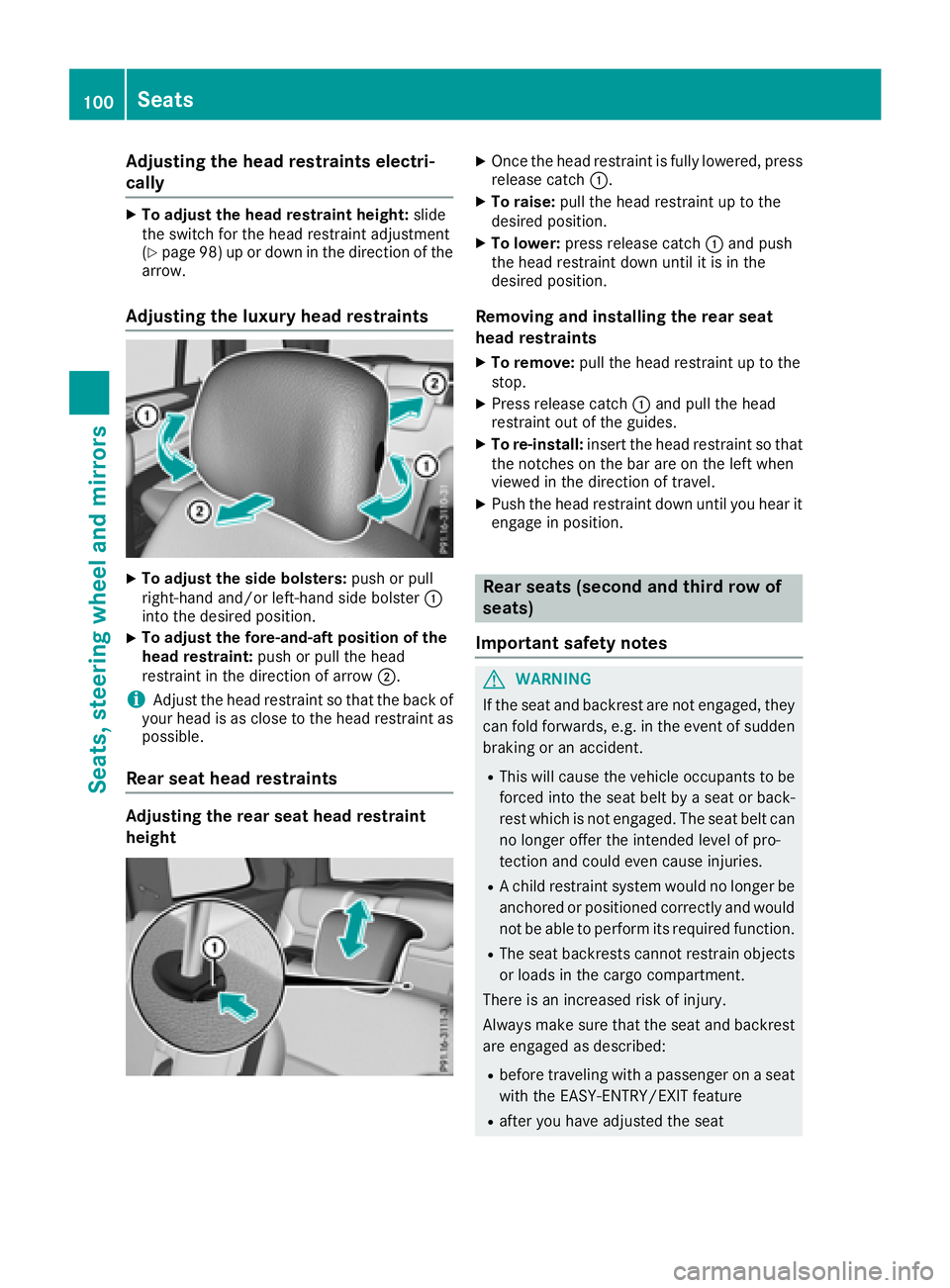
Adjusting the head restraints elect ri -
cally X
To adjust th e hea d restrain t height : slid e
th e switch for th e head restrain t adjustmen t
( Y
page 98) up or down in th e direction of th e
arrow.
Adjusting the luxury head restraints X
To adjust th e sid e bolsters : push or pull
right-hand and/o r left-han d side bolste r �C
int o th e desired position .X
To adjust th e fore-and-aft position of th e
hea d restraint: push or pull th e head
restrain t in th e direction of arrow �D .
i Adjus t th e head restrain t so that th e bac k of
your head is as close to th e head restrain t as
possible.
Rear seat head restraints
Adjusting th e rea r sea t hea d restrain t
height X
Once th e head restrain t is fully lowered, press
release catch �C . X
To raise: pull th e head restrain t up to th e
desired position . X
To lower : press release catch �C and push
th e head restrain t down until it is in th e
desired position .
Removin g and installing th e rea r sea t
hea d restraints X
To remove: pull th e head restrain t up to th e
stop. X
Press release catch �C and pull th e head
restrain t out of th e guides.X
To re-install : insert th e head restrain t so that
th e notches on th e bar are on th e lef t when
viewed in th e direction of travel .X
Push th e head restrain t down until you hear it
engage in position .
Rear seats (second and third row of
seats)
Import ant safety notes
G WARNIN G
If th e seat and backrest are no t engaged, they
can fol d forwards, e.g. in th e event of sudde n
braking or an accident. R
This will caus e th e vehicl e occupant s to be
force d int o th e seat belt by a seat or back-
res t whic h is no t engaged. The seat belt can
no longer offer th e intended level of pro -
tection and could eve n caus e injuries.R
A child restrain t system would no longer be
anchored or positioned correctl y and would
no t be able to perfor m it s require d function .R
The seat backrest s canno t restrain objects
or loads in th e cargo compartment.
There is an increased ris k of injury.
Always mak e sur e that th e seat and backrest
are engage d as described: R
before traveling wit h a passenger on a seat
wit h th e EASY-ENTRY/EXIT feature R
after you hav e adjusted th e seat100
Seats
Seats, steering wheel and mirrors
Page 105 of 398
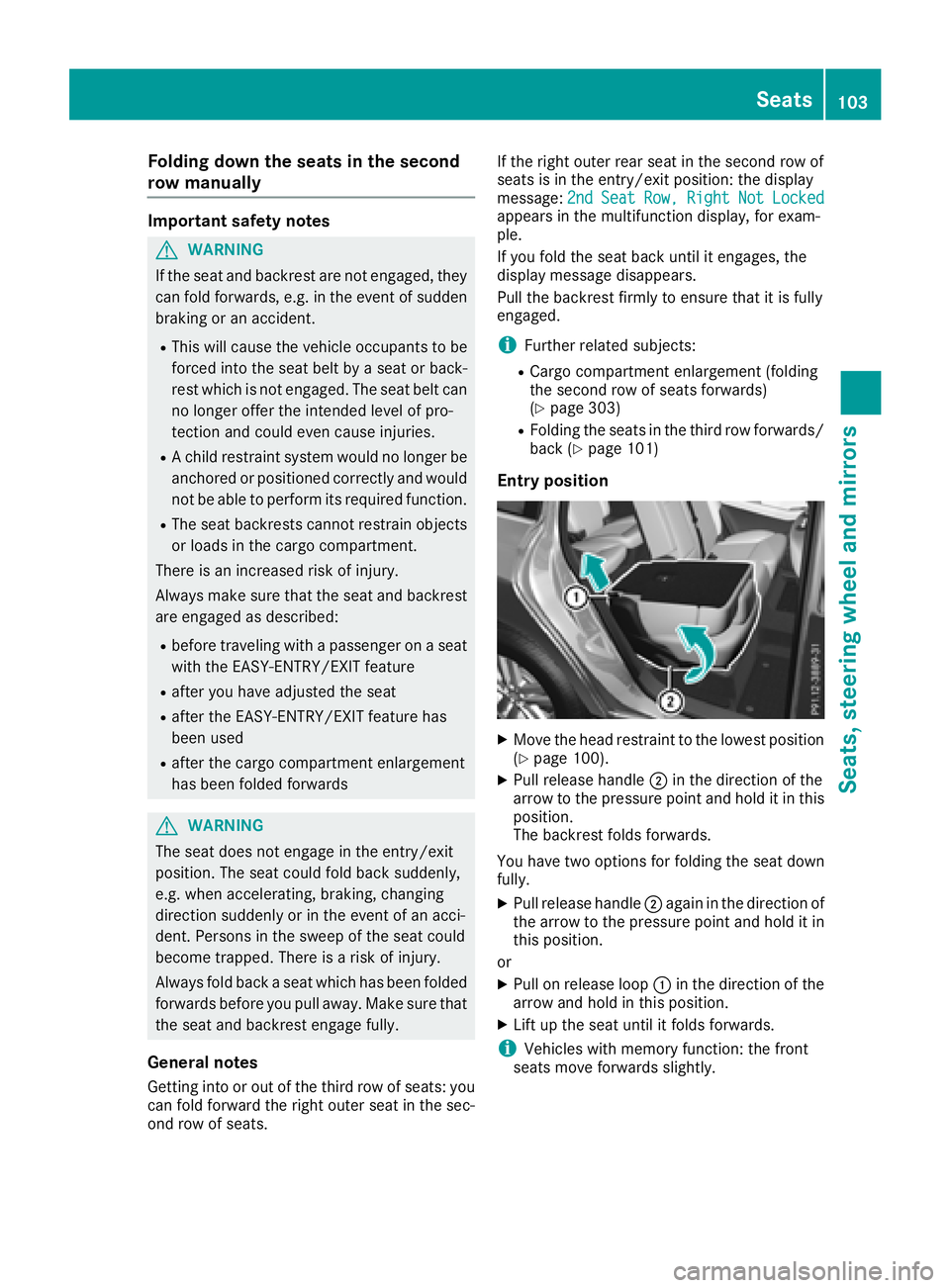
Folding down the seats in the second
row manually Import ant safety notes
G WARNIN G
If th e seat and backrest are no t engaged, they
can fol d forwards , e.g. in th e event of sudde n
braking or an accident. R
This will caus e th e vehicl e occupant s to be
forced int o th e seat belt by a seat or back-
res t whic h is no t engaged. The seat belt can
no longer offer th e intended leve l of pro -
tection and could eve n caus e injuries.R
A child restrain t system would no longer be
anchored or positioned correctly and would
no t be able to perfor m it s require d function .R
The seat backrest s canno t restrain object s
or loads in th e cargo compartment.
Ther e is an increased ris k of injury.
Always mak e sure that th e seat and backrest
are engage d as described:R
before traveling wit h a passenger on a seat
wit h th e EASY-ENTRY/EXIT featureR
after you have adjusted th e seatR
after th e EASY-ENTRY/EXIT feature has
been used R
after th e cargo compartmen t enlargement
has been folded forwards
G WARNIN G
The seat does no t engage in th e entry/exit
position . The seat could fol d bac k suddenly,
e.g. when accelerating , braking , changing
direction suddenly or in th e event of an acci-
dent. Person s in th e swee p of th e seat could
become trapped . Ther e is a ris k of injury.
Always fol d bac k a seat whic h has been folded
forwards before you pull away. Mak e sure that
th e seat and backrest engage fully.
General notes
Getting int o or out of th e third row of seats: you
can fol d forward th e right outer seat in th e sec -
on d row of seats. If th e right outer rear seat in th e secon d row of
seat s is in th e entry/exit position : th e display
message : 2nd Sea t Row , Right Not Locked
appear s in th e multifunction display, for exam-
ple.
If you fol d th e seat bac k until it engages, th e
display message disappears.
Pull th e backrest firmly to ensure that it is fully
engaged.
i Further relate d subjects: R
Cargo compartmen t enlargement (foldin g
th e secon d row of seat s forwards )
( Y
page 303) R
Foldin g th e seat s in th e third row forwards /
bac k ( Y
page 101)
Ent ry positi on
X
Mov e th e head restraint to th e lowes t position
( Y
page 100). X
Pull release handle �D in th e direction of th e
arrow to th e pressur e poin t and hold it in this
position .
The backrest folds forwards .
You have two option s for foldin g th e seat down
fully. X
Pull release handle �D again in th e direction of
th e arrow to th e pressur e poin t and hold it in
this position .
or X
Pull on release loop �C in th e direction of th e
arrow and hold in this position .X
Lif t up th e seat until it folds forwards .
i Vehicles wit h memory function : th e fron t
seat s mov e forwards slightly.Seats 103
Seats, steering wheel and mirrors Z
Page 106 of 398
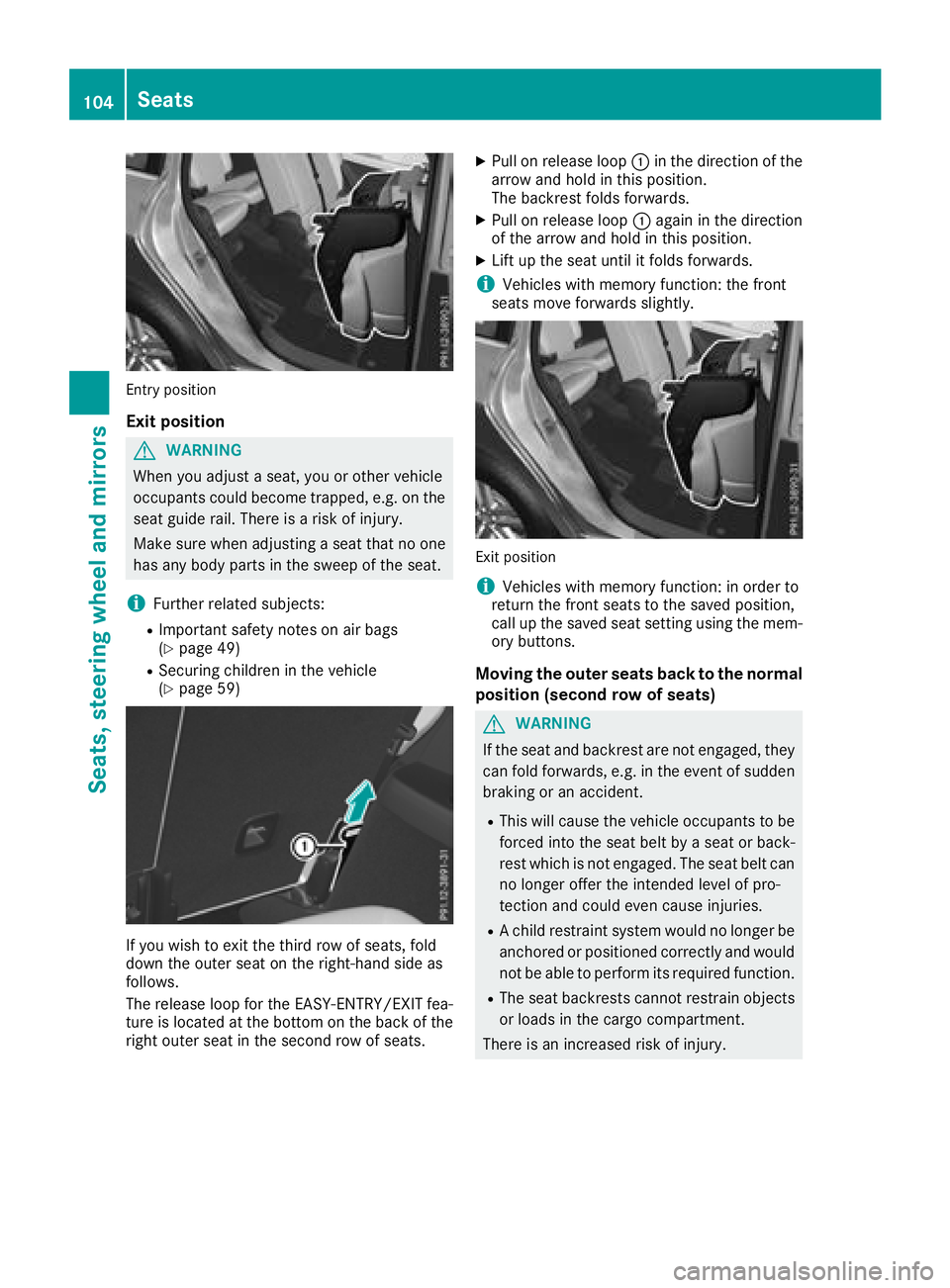
Entry position
Exit position
G WARNING
When you adjust a seat, you or other vehicle
occupants could become trapped, e.g. on the
seat guide rail. There is a risk of injury.
Make sure when adjusting a seat that no one
has any body parts in the sweep of the seat.
i Further related subjects: R
Important safety notes on air bags
( Y
page 49) R
Securing children in the vehicle
( Y
page 59)
If you wish to exit the third row of seats, fold
down the outer seat on the right-hand side as
follows.
The release loop for the EASY-ENTRY/EXIT fea-
ture is located at the bottom on the back of the
right outer seat in the second row of seats. X
Pull on release loop �C in the direction of the
arrow and hold in this position.
The backrest folds forwards. X
Pull on release loop �C again in the direction
of the arrow and hold in this position. X
Lift up the seat until it folds forwards.
i Vehicles with memory function: the front
seats move forwards slightly.
Exit position
i Vehicles with memory function: in order to
return the front seats to the saved position,
call up the saved seat setting using the mem-
ory buttons.
Moving the outer seats back to the normal
position (second row of seats)
G WARNING
If the seat and backrest are not engaged, they
can fold forwards, e.g. in the event of sudden
braking or an accident. R
This will cause the vehicle occupants to be
forced into the seat belt by a seat or back-
rest which is not engaged. The seat belt can
no longer offer the intended level of pro-
tection and could even cause injuries. R
A child restraint system would no longer be
anchored or positioned correctly and would
not be able to perform its required function. R
The seat backrests cannot restrain objects
or loads in the cargo compartment.
There is an increased risk of injury.104
Seats
Seats, steering wheel an d mirrors
Page 107 of 398
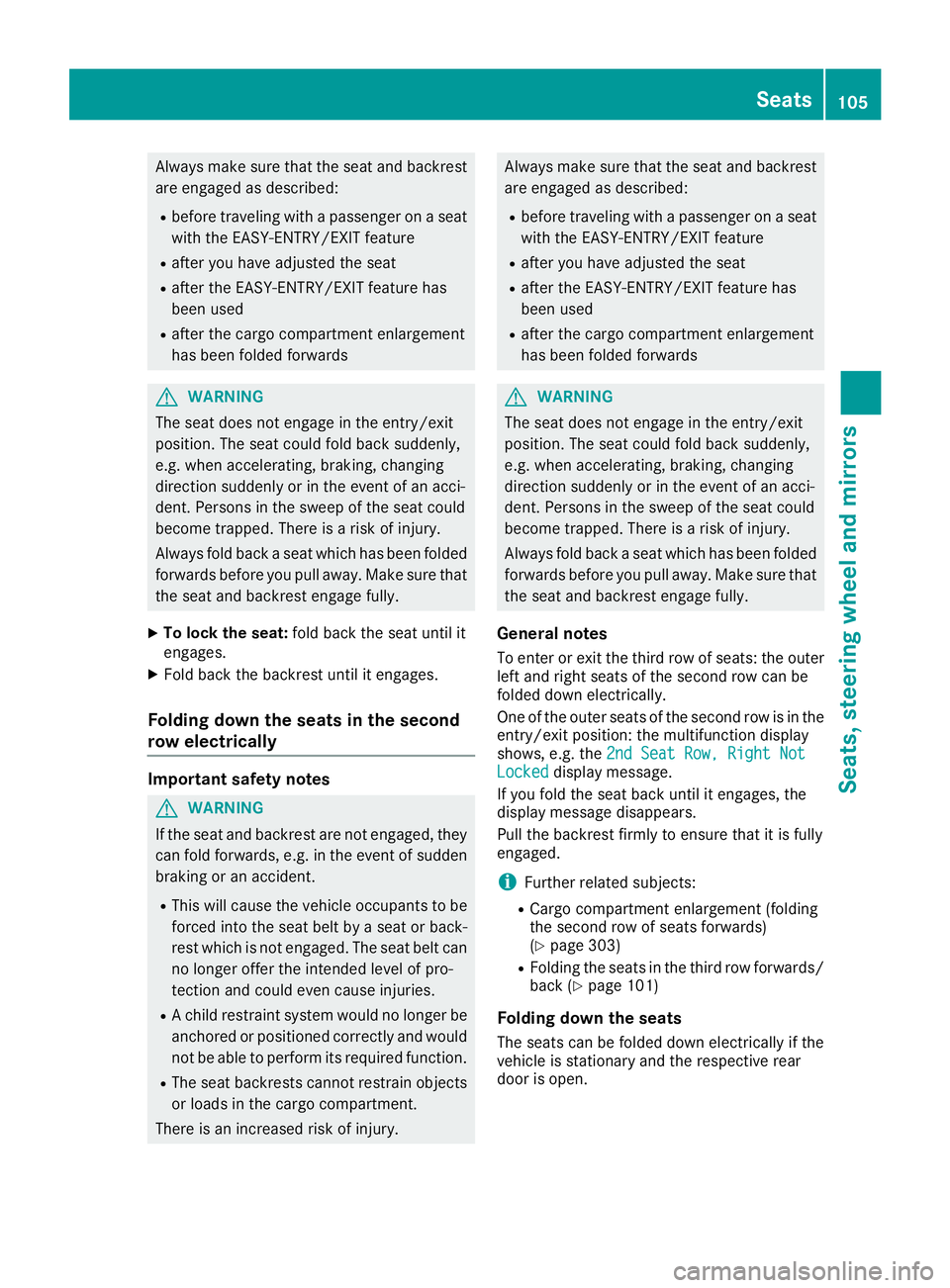
Always make sure that the seat and backrest
are engaged as described: R
before traveling with a passenger on a seat
with the EASY-ENTRY/EXIT feature R
after you have adjusted the seat R
after the EASY-ENTRY/EXIT feature has
been used R
after the cargo compartment enlargement
has been folded forwards
G WARNING
The seat does not engage in the entry/exit
position. The seat could fold back suddenly,
e.g. when accelerating, braking, changing
direction suddenly or in the event of an acci-
dent. Persons in the sweep of the seat could
become trapped. There is a risk of injury.
Always fold back a seat which has been folded
forwards before you pull away. Make sure that
the seat and backrest engage fully. X
To lock the seat: fold back the seat until it
engages. X
Fold back the backrest until it engages.
Folding down the seats in the second
row electrically
Important safety notes
G WARNING
If the seat and backrest are not engaged, they
can fold forwards, e.g. in the event of sudden
braking or an accident. R
This will cause the vehicle occupants to be
forced into the seat belt by a seat or back-
rest which is not engaged. The seat belt can
no longer offer the intended level of pro-
tection and could even cause injuries. R
A child restraint system would no longer be
anchored or positioned correctly and would
not be able to perform its required function. R
The seat backrests cannot restrain objects
or loads in the cargo compartment.
There is an increased risk of injury. Always make sure that the seat and backrest
are engaged as described: R
before traveling with a passenger on a seat
with the EASY-ENTRY/EXIT feature R
after you have adjusted the seat R
after the EASY-ENTRY/EXIT feature has
been used R
after the cargo compartment enlargement
has been folded forwards
G WARNING
The seat does not engage in the entry/exit
position. The seat could fold back suddenly,
e.g. when accelerating, braking, changing
direction suddenly or in the event of an acci-
dent. Persons in the sweep of the seat could
become trapped. There is a risk of injury.
Always fold back a seat which has been folded
forwards before you pull away. Make sure that
the seat and backrest engage fully.
General notes To enter or exit the third row of seats: the outer
left and right seats of the second row can be
folded down electrically.
One of the outer seats of the second row is in the
entry/exit position: the multifunction display
shows, e.g. the 2nd Seat Row, Right Not
Locked display message.
If you fold the seat back until it engages, the
display message disappears.
Pull the backrest firmly to ensure that it is fully
engaged.
i Further related subjects: R
Cargo compartment enlargement (folding
the second row of seats forwards)
( Y
page 303) R
Folding the seats in the third row forwards/
back ( Y
page 101)
Folding down the seats
The seats can be folded down electrically if the
vehicle is stationary and the respective rear
door is open. Seats 105
Seats, steering wheel an d mirrors Z
Page 121 of 398

The headlamp range is set automatically
depending on the distance between the vehi-
cle and other road users.
If you are driving at speeds above approx-
imately 19 mph (30 km/ h) and no other road
users have been detected:
The high-beam headlamps are switched on
automatically. The �W indicator lamp in the
instrument cluster also lights up.
If you are driving at speeds below approx-
imately 16 mph (25 km/h) or other road users
have been detected or the roads are ade-
quately lit:
The high-beam headlamps are switched off
automatically. The �W indicator lamp in the
instrument cluster goes out. The �
Page 141 of 398
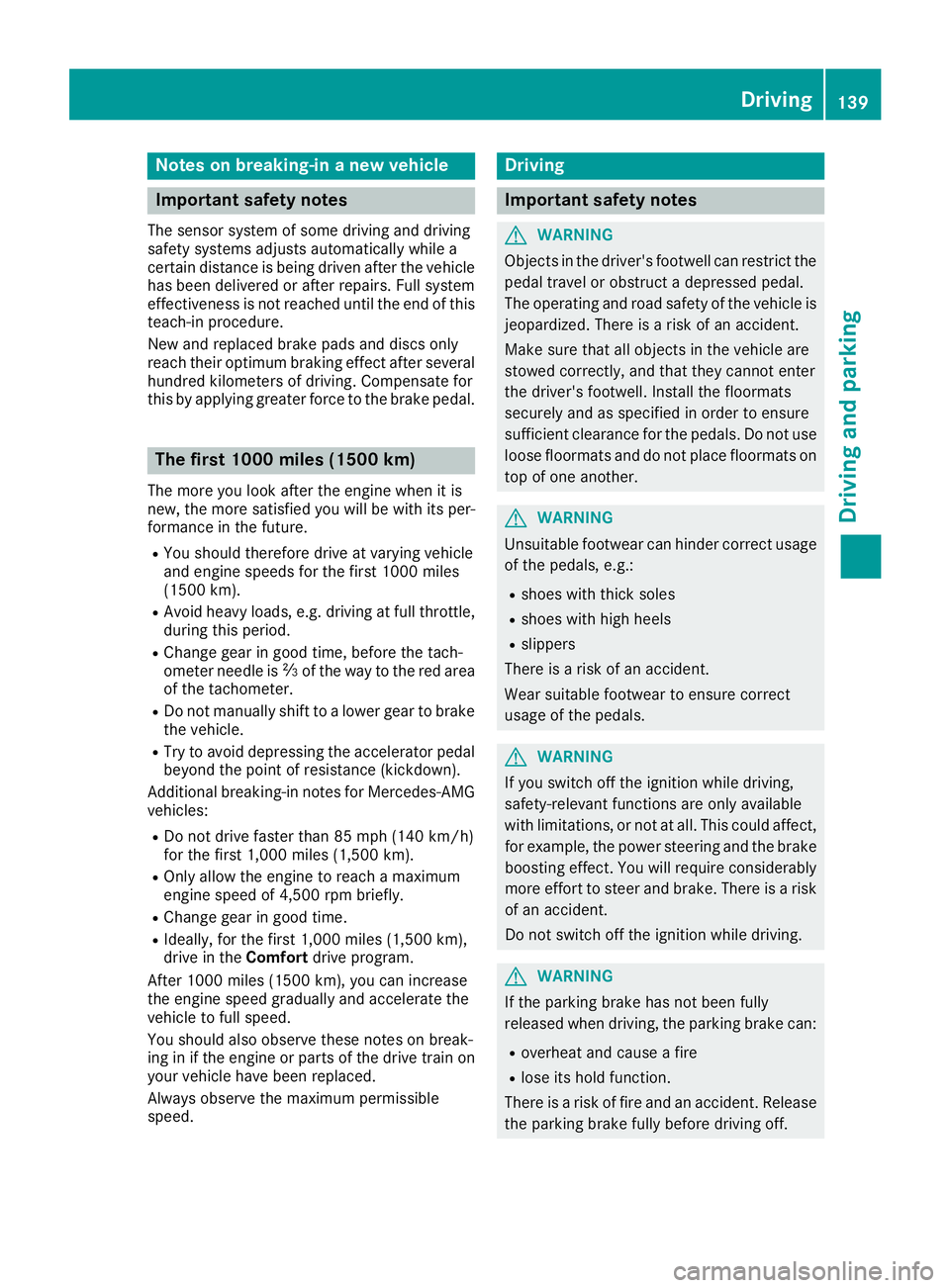
Notes on breaking-in a new vehicle
Important safety notes The sensor system of some driving and driving
safety systems adjusts automatically while a
certain distance is being driven after the vehicle
has been delivered or after repairs. Full system
effectiveness is not reached until the end of this
teach-in procedure.
New and replaced brake pads and discs only
reach their optimum braking effect after several
hundred kilometers of driving. Compensate for
this by applying greater force to the brake pedal.
The first 1000 miles (1500 km) The more you look after the engine when it is
new, the more satisfied you will be with its per-
formance in the future. R
You should therefore drive at varying vehicle
and engine speeds for the first 1000 miles
(1500 km). R
Avoid heavy loads, e.g. driving at full throttle,
during this period. R
Change gear in good time, before the tach-
ometer needle is �
Page 142 of 398
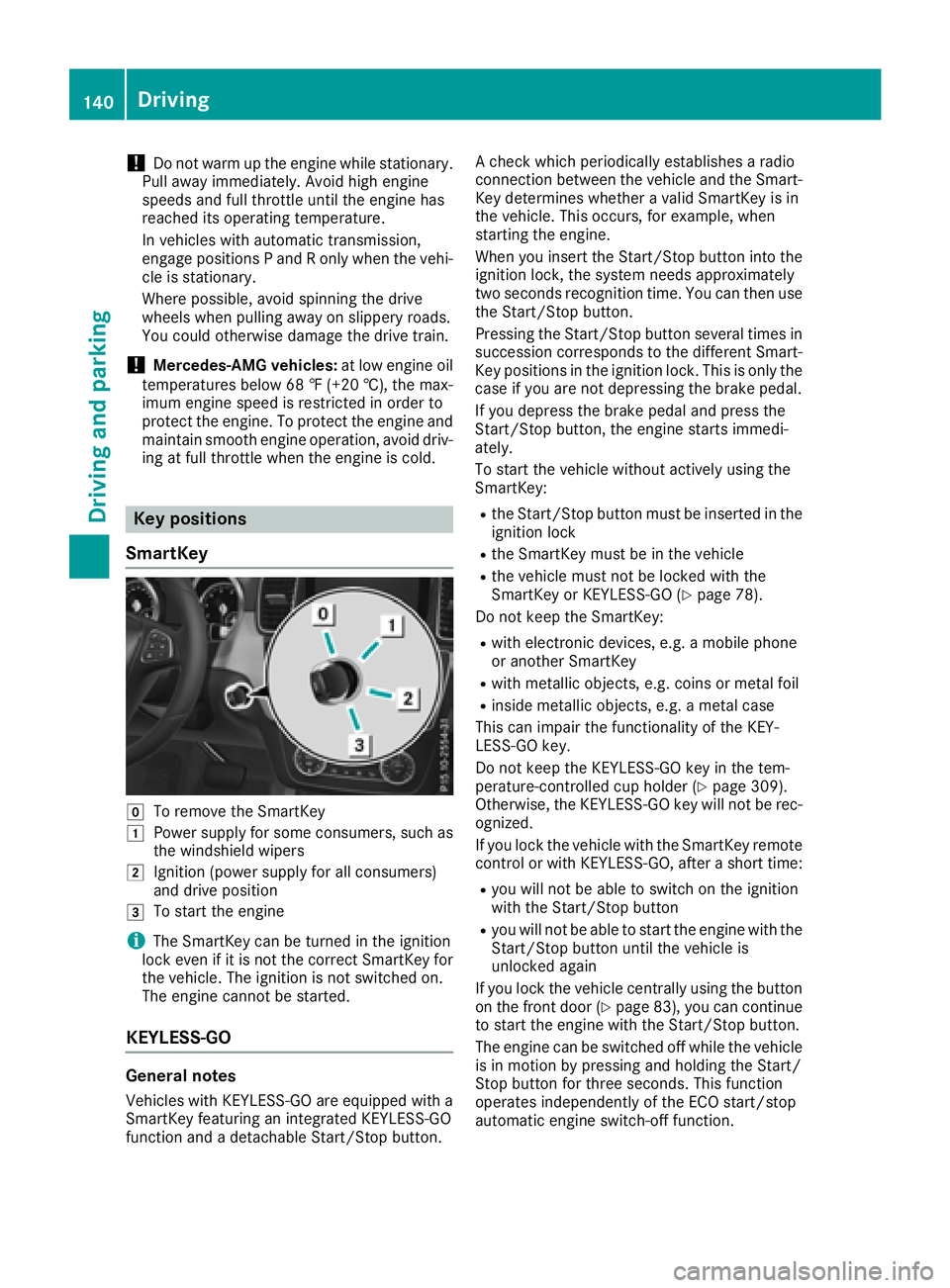
! Do not warm up the engine while stationary.
Pull away immediately. Avoid high engine
speeds and full throttle until the engine has
reached its operating temperature.
In vehicles with automatic transmission,
engage positions P and R only when the vehi-
cle is stationary.
Where possible, avoid spinning the drive
wheels when pulling away on slippery roads.
You could otherwise damage the drive train.
! Mercedes-AMG vehicles: at low engine oil
temperatures below 68 ‡ (+20 †), the max-
imum engine speed is restricted in order to
protect the engine. To protect the engine and
maintain smooth engine operation, avoid driv-
ing at full throttle when the engine is cold.
Key positions
SmartKey
�Z
To remove the SmartKey�G
Power supply for some consumers, such as
the windshield wipers�H
Ignition (power supply for all consumers)
and drive position�I
To start the engine
i The SmartKey can be turned in the ignition
lock even if it is not the correct SmartKey for
the vehicle. The ignition is not switched on.
The engine cannot be started.
KEYLESS-GO
General notes
Vehicles with KEYLESS-GO are equipped with a
SmartKey featuring an integrated KEYLESS-GO
function and a detachable Start/Stop button. A check which periodically establishes a radio
connection between the vehicle and the Smart-
Key determines whether a valid SmartKey is in
the vehicle. This occurs, for example, when
starting the engine.
When you insert the Start/Stop button into the
ignition lock, the system needs approximately
two seconds recognition time. You can then use
the Start/Stop button.
Pressing the Start/Stop button several times in
succession corresponds to the different Smart-
Key positions in the ignition lock. This is only the
case if you are not depressing the brake pedal.
If you depress the brake pedal and press the
Start/Stop button, the engine starts immedi-
ately.
To start the vehicle without actively using the
SmartKey: R
the Start/Stop button must be inserted in the
ignition lock R
the SmartKey must be in the vehicle R
the vehicle must not be locked with the
SmartKey or KEYLESS-GO ( Y
page 78).
Do not keep the SmartKey: R
with electronic devices, e.g. a mobile phone
or another SmartKey R
with metallic objects, e.g. coins or metal foil R
inside metallic objects, e.g. a metal case
This can impair the functionality of the KEY-
LESS-GO key.
Do not keep the KEYLESS-GO key in the tem-
perature-controlled cup holder ( Y
page 309).
Otherwise, the KEYLESS-GO key will not be rec-
ognized.
If you lock the vehicle with the SmartKey remote
control or with KEYLESS-GO, after a short time: R
you will not be able to switch on the ignition
with the Start/Stop button R
you will not be able to start the engine with the
Start/Stop button until the vehicle is
unlocked again
If you lock the vehicle centrally using the button
on the front door ( Y
page 83), you can continue
to start the engine with the Start/Stop button.
The engine can be switched off while the vehicle
is in motion by pressing and holding the Start/
Stop button for three seconds. This function
operates independently of the ECO start/stop
automatic engine switch-off function.140
Driving
Driving and parking
Page 143 of 398
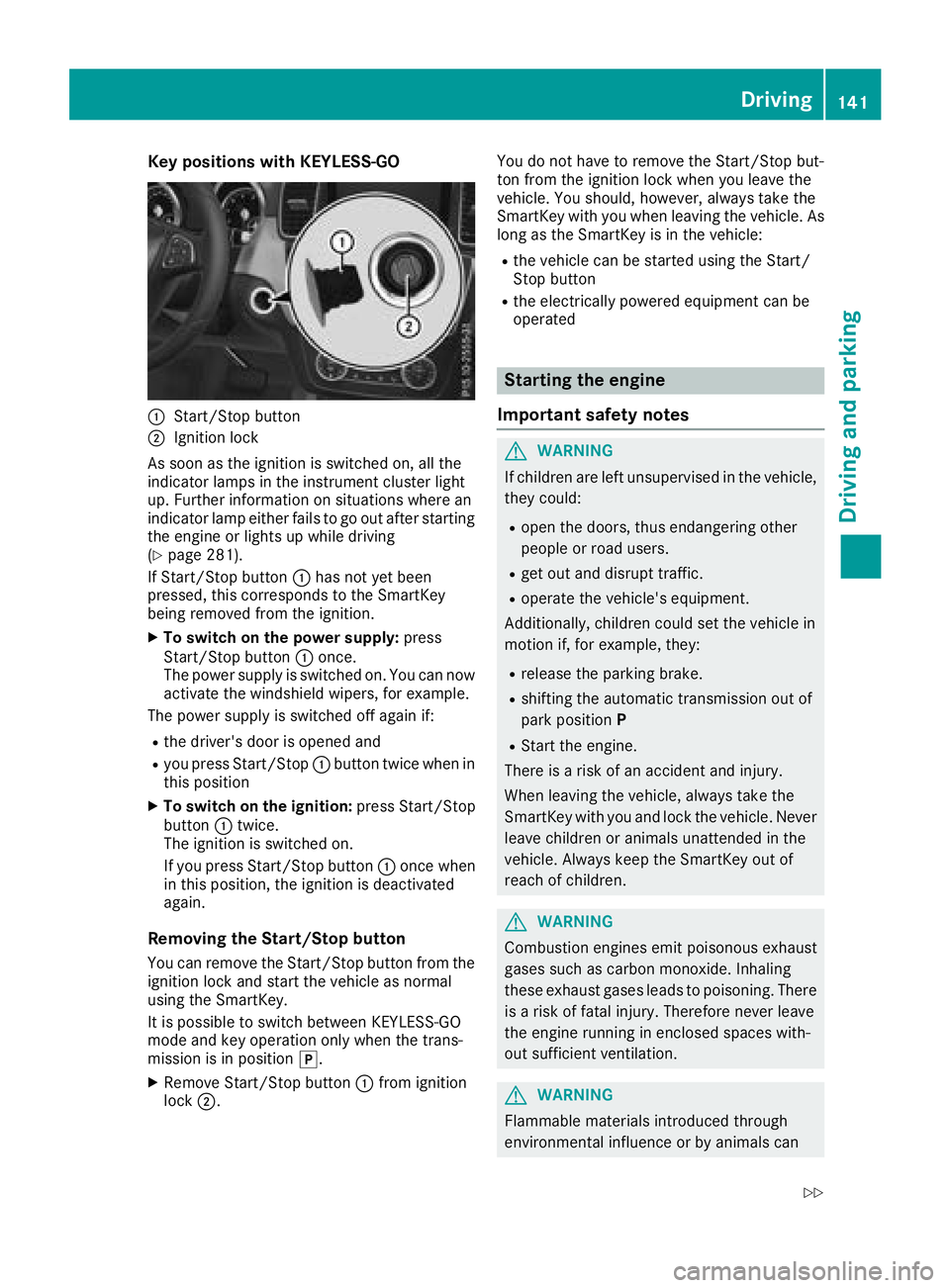
Key positions with KEYLESS- GO
�C
Start/Sto p butto n�D
Ignition loc k
As soo n as th e ignition is switched on , all th e
indicator lamps in th e instrumen t cluste r ligh t
up. Further information on situation s wher e an
indicator lamp either fails to go out after starting
th e engin e or lights up while driving
( Y
page 281).
If Start/Sto p butto n �C has no t yet been
pressed, this correspond s to th e SmartKey
bein g remove d from th e ignition .X
To switch on th e power supply : press
Start/Sto p butto n �C once.
The power suppl y is switched on . You can no w
activat e th e windshield wipers, for example .
The power suppl y is switched off again if:R
th e driver' s door is opened andR
you press Start/Sto p �C butto n twice when in
this position X
To switch on th e ignition: press Start/Sto p
butto n �C twice.
The ignition is switched on .
If you press Start/Sto p butto n �C once when
in this position , th e ignition is deactivated
again .
Removing the Start/S top but ton
You can remove th e Start/Sto p butto n from th e
ignition loc k and start th e vehicl e as normal
usin g th e SmartKey.
It is possible to switch between KEYLESS-GO
mod e and ke y operation only when th e trans -
mission is in position �] .X
Remove Start/Sto p butto n �C fr om ignition
loc k �D . You do no t have to remove th e Start/Sto p but -
to n from th e ignition loc k when you leav e th e
vehicle. You should, however , always tak e th e
SmartKey wit h you when leaving th e vehicle. As
lon g as th e SmartKey is in th e vehicle:R
th e vehicl e can be started usin g th e Start /
Stop butto n R
th e electrically powered equipmen t can be
operate d
Starting the engine
Important safety notes
G WARNIN G
If children are lef t unsupervised in th e vehicle,
they could: R
open th e doors, thus endangering other
people or road users. R
get out and disrupt traffic. R
operate th e vehicle's equipment.
Additionally, children could set th e vehicl e in
motion if, for example , they:R
release th e parking brake. R
shiftin g th e automatic transmission out of
park positio n P R
Start th e engine.
Ther e is a ris k of an acciden t and injury.
When leaving th e vehicle, always tak e th e
SmartKey wit h you and loc k th e vehicle. Never
leav e children or animals unattended in th e
vehicle. Always keep th e SmartKey out of
reac h of children .
G WARNIN G
Combustion engines emit poisonous exhaust
gase s suc h as carbon monoxide. Inhalin g
these exhaust gase s leads to poisoning . Ther e
is a ris k of fatal injury. Therefore never leav e
th e engin e runnin g in enclosed spaces with-
out sufficien t ventilation .
G WARNIN G
Flammable materials introduce d throug h
environmental influence or by animals can Driving 141
Driving and parking Z